Revista de Ciencias de la Comunicación e Información. Año. Vol. 29, 1-20
ISSN 2695-5016
ANALYSIS OF VISUAL BRAND IDENTITY IN THE FAST-FOOD SECTOR: A NEUROMARKETING STUDY
ANÁLISIS DE LA IDENTIDAD VISUAL DE MARCA EN EL SECTOR DE LA COMIDA RÁPIDA: UN ESTUDIO DE NEUROMARKETING
Natividad Crespo-Tejero: ESIC University. Spain.
Sara Comendador Díaz-Maroto: Alsea, Foster´s Hollywood. Spain.
Susana Fernandez-Lores: ESIC University. Business & Marketing School. Spain.
How to cite this article:
Crespo-Tejero, Natividad; Comendador Díaz-Maroto, Sara, & Fernandez-Lores, Susana (2024). Analysis of visual brand identity in the fast-food sector: a neuromarketing study [Análisis de la identidad visual de marca en el sector de la comida rápida: un estudio de neuromarketing]. Revista de Ciencias de la Comunicación e Información, 29, 1-20. https://doi.org/10.35742/rcci.2024.29.e300
ABSTRACT
Introduction: Brand strategy is a key element in any FMCG company and measuring its impact on consumers is a must. The objective of this study is to analyze the cognitive, affective and behavioral responses generated by the visual communication elements used by two companies (Foster’s Hollywood and VICIO) in order to identify the best strategies developed. Methodology: An experiment was designed applying different neurophysiological techniques: electroencephalogram (EEG), eye tracking and galvanic skin response (GSR). A sample of 18 subjects, aged 22-30 years, participated in the experiment. The stimuli used included physical and digital communication elements. The devices used as well as the analysis software were provided by BitBrain Technologies. Results: It is worth noting that there are significant differences in valence in favor of VICIO and in memorization in favor of Foster’s Hollywood in the images analyzed in Instragram. In addition, although the differences found are not significant, it is observed that VICIO’s architecture on the website generates greater engagement and liking; while VICIO’s outdoor advertising elements obtain better scores in all metrics. Discussion: The style used by the VICIO brand seems to generate a greater impact on users’ affective responses. Conclusions: This study contributes to a better understanding of the effects of communication strategies by identifying which tools work most effectively in building a powerful brand image.
Keywords: neuroscience, branding, visual image, electroencephalogram (EEG), galvanic skin response (GSR), eye tracking, neuromarketing.
RESUMEN
Introducción: La estrategia de marca es un elemento clave en cualquier compañía de gran consumo y medir el impacto que genera sobre los consumidores es un requisito imprescindible. El objetivo de este estudio es analizar las respuestas cognitivas, afectivas y comportamentales que generan los elementos visuales de comunicación que utilizan dos compañías (Foster´s Hollywood y VICIO) con la finalidad de identificar las mejores estrategias desarrolladas. Metodología: Se diseñó un experimento aplicando diferentes técnicas neurofisiológicas: electroencefalograma (EEG), seguimiento ocular (eye tracking) y respuesta galvánica de la piel (GSR). Una muestra de 18 sujetos, entre los 22-30 años participaron en el experimento. Los estímulos utilizados incluían elementos de comunicación físicos y digitales. Los dispositivos utilizados, así como el software de análisis fueron proporcionados por BitBrain Technologies. Resultados: Cabe destacar que existen diferencias significativas en la valencia a favor de VICIO y en memorización a favor de Foster´s Hollywood en las imágenes analizadas en Instragram. Además, aunque las diferencias encontradas no llegan a ser significativas, se observa que la arquitectura de VICIO en la página web genera mayor engagement y agrado; mientras que los elementos de la publicidad exterior de VICIO obtienen mejores puntuaciones en todas las métricas. Discusión: El estilo utilizado por la marca VICIO parece generar un mayor impacto en las respuestas afectivas de los usuarios. Conclusiones: Este estudio contribuye a una mejor comprensión de los efectos de las estrategias de comunicación identificando qué herramientas funcionan de manera más eficaz a la hora de construir una imagen de marca potente.
Palabras clave: neurociencia, marca, imagen visual, electroencefalograma (EEG), respuesta galvánica de la piel (GSR), eye tracking, neuromarketing.
1. INTRODUCTION
The decisive role of brands and their relationship with consumers is something undisputed, unanimously assumed by both academics and marketing and management professionals (Whan et al., 2010). For decades, its strategic value for organizations has only grown and increased, providing important and unique benefits, which have nurtured countless studies and publications of all kinds. The brand is today one of the main intangible assets (Madden et al., 2006).
Brand identity is said to be the unique set of associations that an organization aspires to create and maintain (Jan-Alsem and Kostelijk, 2008). These associations are the essential brand characteristics and attributes that can give rise to perceived brand personality (Aaker et al., 2004) and brand relationships with consumers (Fournier, 1998). When consumers seek, buy and consume brands, they are exposed to specific stimuli related to the brand, such as logos, colors, shapes, typefaces, characters, styles and other elements, which form the brand image and identify it. These elements are abundantly present in most brand advertising and communication elements (Phillips et al., 2014).
Branding strategies encompass the creation of mental structures that help the target audience organize their knowledge regarding a certain product or organization. By doing this, the target audience is able to clarify their decision making with respect to that product or organization. In addition, it improves the purchasing habits of consumers, thus generating value for the organization (Fernandez-Lores et al., 2014).
In an economic context in which every day new brands emerge that offer products similar to those already existing in the market, companies are constantly struggling to position themselves in the consumer's mind, either through traditional or digital media. Audiences seek differential aspects that justify their choice of purchase, which is why brands must make a much more personal communication where the customer identifies with it (Arbona, 2021).
This situation is not alien to fast food restaurants in Spain. Companies in this sector face strong competition, where differentiation becomes a key element for business success. In this scenario, the role of brands becomes vitally important as a determining factor that goes beyond the simple identification of an establishment. Brands are not only names and logos; they represent the spirit, quality and experience that a consumer associates with a particular restaurant (Osman et al., 2014).
The Spanish fast-food market, especially following the pandemic, is in full expansion. Thus, new partners have recently been incorporated with innovative proposals very focused on the younger generations and which are competing with the more classic companies, solidly established in the Spanish scenario. Senior brands such as McDonalds, Burger King or Foster's Hollywood have seen the irruption of new competitors such as VICIO or TGB in this market. According to Informa's DBK Sector Observatory, the fast-food market in Spain is clearly on the rise. In fact, in 2022 it recorded a strong growth in its consumption, reaching total sales of 4,680 million euros, adding 18.6% in 2022, and after having increased by 27.3% in 2021. Furthermore, 60% of turnover comes from outlets specializing in hamburgers, so the leading fast-food brands are growing steadily (+25%), far outstripping pizzerias and other types of outlets (Infohoreca, 2023).
Therefore, in the fast-food restaurant sector in Spain, brands are not only visual labels, but an integral part of business success. From emotional connection to differentiation and trust building, brands play a key role in creating memorable experiences that endure in the minds of consumers and ensure the long-term viability of outlets.
1.1. Brand identity/visual identity
Brand strategy is a key element in any FMCG company and measuring the impact it generates on consumers is a must. However, the growth in the number of brands in our contemporary world creates difficulties for many companies that have to compete with new competitors, making the process of perception of visual identities much more complex, thereby hindering the process of identification of companies by consumers (Moraes-de-Figueiredo et al., 2017). Likewise, the rise of social networks and the communication of brands in digital media has favored interest in the study of the impact of the stimuli that define the corporate visual identity of large brands (Mañas-Viniegra et al., 2020).
The corporate identity of a company has traditionally been identified as key to building the image of a brand in the eyes of its public (Capriotti, 2009). In turn, visual identity expresses and symbolically embodies the essence of the brand in a graphic-visual format that communicates the values, personality and corporate culture (Mañas-Viniegra et al., 2020). Thus, companies use creative marketing messages to promote the characteristics and values of the brand, both through traditional and digital media (Gensler et al., 2013). Specifically, in digital media, visual brand content is especially significant in communicating brand identity. For example, when consumers interact with brands online, they are continuously exposed to visual elements of branded content, such as logos, colors and other brand identity images. According to different authors, visual content affects the quality of interaction between brand content and consumers (Lee et al., 2015). In this regard, different lines of research have shown that effectively produced advertising images positively influence brand recall (Ferguson and Mohan, 2020), attitude towards the brand (Schmuck et al., 2018) and purchase intention (Lee et al., 2015).
Using Aaker's (1996) brand identity planning model as a theoretical framework, different studies have examined the effects of various advertising design elements in building brand identity through visual strategies (Zhou and Xue, 2021). Aaker (1996) developed a three-stage model (the strategic brand analysis, the brand identity system and the brand identity implementation system) based on the brand identity system. The model provides an approach for establishing lasting relationships with customers and thus creating and maintaining effective brands.
To identify the impact of visual brand identity elements, traditional techniques such as self-reporting have been used in preference. However, different researchers are starting to use neuroscience tools to analyze the responses generated by the visual communication elements of different companies, providing scientifically measurable cognitive and emotional results, in order to identify the best strategies developed (Mañas-Viniegra et al., 2020).
1.2. Consumer Neuroscience
Traditional methods for analyzing the impact of visual brand image are based on self-report questionnaires and, rely heavily on subjects' ability to describe their levels of attention, emotions, or behavioral intentions in relation to viewed images (Gountas et al., 2019). In addition, self-report measures analyze conscious responses, but the validity of these assessments is often biased by cognitive or social desirability constraints (Poels and DeWitte, 2006). Aiming to overcome these limitations, academic and commercial research has been implementing neurophysiological methods to study dimensions of the effectiveness of marketing and advertising strategies. Consumer neuroscience, the use of neurophysiological research methods offers access to consumers' mental processes and is therefore often used to complement traditional self-reported measures to improve understanding of individuals' behavior, given that they do not require an active or conscious response from participants (Pozharliev et al., 2017).
Neuroscience provides empirical research techniques to measure non-conscious preferences and cognitive and affective processes as well as decision making in consumer research (Harris et al., 2018). Therefore, many studies use neuroscientific methodologies applying multiple neurophysiological tools such as electroencephalogram (EEG), galvanic skin response (GSR), heart rate, and eye-tracking (ET), among others (Harris et al., 2018).
1.3. Neuroscience in food marketing and communication
In recent years, the literature review shows that studies incorporating neuroscience research techniques have undergone a remarkable development, facilitating the understanding of consumer brain mechanisms in the choice and purchase process. In particular, many of these studies have been interested in the analysis of branding and packaging. For example, the recent publication of the review by Rodríguez et al. (2023), where the authors analyze in detail the main findings in these areas from the field of consumer neuroscience. Among other aspects, they highlight that certain biometric correlates confirm that skin conductance was reduced when consumers saw the brand they liked the most (Walla et al., 2011). Other authors, Langner et al. (2015) confirmed that beloved brands can be as exciting as close friends and raise more positive valence than interpersonal relationships. For their part, Huber et al. (2019) found that attractive packaging activated regions associated with reward, whereas unattractive packaging activated regions associated with negative emotions. On the other hand, Berčík et al. (2021) have used biometric or neuroimaging methods in relation to gastronomy. The authors found that important visual factors influencing the perception of presented food include its distance from the consumer, variety, diversity, distribution on a plate, portion size, and the gastronomic service (dishes) used.
Focusing on the food field, Stasi et al. (2018) conduct a literature review regarding the use of neuromarketing in that sector. The results indicate that, in general, consumers' neurological reactions have been studied in terms of taste, packaging (label and brand information), communication and pricing. In addition, the authors subscribe that the main neuroscience techniques used are EGG, skin conductance and eye tracking. Recently, authors such as David et al. (2023) analyze the emotional content of visual food content with neuroscience tools, identifying the factors in food labeling that most impact consumers' emotional response. On the other hand, Lim et al. (2023) studied different visually displayed foods with different levels of variety, flavor profiles, and nutritional balance. Through EEG, results indicated that, as meal compositions became more diverse and flavorful, participants reported higher levels of liking. In contrast, meals with limited variety received lower liking scores.
Despite the growing popularity of neuroscientific methods to obtain more objective information compared to traditional research methods, little research is conducted on the impact of visual brand identity on consumers (Mañas-Viniegra et al., 2020).
This article shows the results of a neuroscience experiment through the analysis of affective, cognitive and behavioral variables of a group of 18 young people when viewing different visual images of two brands of the casual dining sector: Foster's Hollywood and VICIO. For this purpose, electroencephalogram, electrodermal activity and eye-tracking were used.
1.4. Foster's Hollywood and VICIO
Foster's Hollywood is an American restaurant chain, located in Spain since 1971, which belongs to the casual dining segment. The differential value of the brand lies in transmitting the authentic, aspirational and transversal American essence. Foster's Hollywood targets a reference public between 25-34 years of age. Currently, it competes with brands that have recently entered the market with powerful value propositions, such as VICIO, which is currently in the process of strong growth (Forbes, 2022). In this sense, Foster's Hollywood is perceived as a stagnant and outdated brand, which has forced the company to implement repositioning strategies (Reason Why, 2022). The analysis of Foster's Hollywood's communication is characterized by the combined use of traditional and digital media, with a traditional strategy in the type of images used by the company.
VICIO is a food delivery company that emerged in 2020 founded by two young people, who took advantage of the high demand for delivery orders to set up their own business. In a very short time, the company has achieved rapid expansion, with a turnover of €20 million by 2022 (Forbes, 2022). VICIO has been able to get closer to consumers through the experience of consuming its products using new flavors, different and creative packaging, using emotional aspects in its communication to differentiate itself from the competition and position itself in the minds of its public. VICIO's campaigns are very daring and original, both in message and aesthetics; with a youthful, daring and informal tone that connects very well with the Millennial and Z generations, its target audience. Most of its communication is carried out with these segments in mind, targeting them through social networks and digital channels. Likewise, their campaigns are supported by characters and influencers such as Manu Ríos, Griezman, Jessica Goicochea or Ester Expósito, among others.
2. OBJECTIVES
The main objective of this research is to identify the most effective visual branding strategies in the fast-food restaurant sector in Spain, specifically the so-called casual dining. For this purpose, this study aims to detect the differences in the signals obtained through different neuroscience tools (electroencephalogram, galvanic skin response and eye-tracking), caused by the images of different visual identity elements of two brands with different communication strategies.
3. METHODOLOGY
To achieve the proposed research objective, an experiment was conducted in the neuroscience laboratory of a university in Madrid, in compliance with ethical regulations and confidentiality guarantees. The participants were informed about the experiment and signed their consent before starting the experiment. The sensors were then fixed and calibrated. The task entrusted to the participants consisted of viewing a series of images of different communication elements, both physical and digital, of the two brands under study, grouped by blocks according to the type of communication. In addition, participants had to answer a series of questions through a self-reported online questionnaire, before viewing the images. The fieldwork was carried out during the month of June 2023.
3.1. Stimuli
The stimuli used in the experiment are divided into images obtained from digital and physical media of the two brands studied. Regarding digital media, different images from the Instagram feed and Instagram posts have been selected. In addition, images from the website of both companies have been analyzed. Likewise, images from the outdoor advertising and menu of the two brands have been analyzed. The selected stimuli are detailed below:
Block 1. Instagram Feeds
Image 1. Foster´s Hollywood Instagram Feed
Image 2. VICIO Instagram Feed
Block 2. Instagram Posts
Image 3. Foster´s Hollywood Instagram Picture (ribbons)
Image 4. Foster´s Hollywood Instagram Picture (hamburger)
Image 5. Foster´s Hollywood Instagram Picture (chicken wings)
Image 6. VICIO Instagram Picture (dog)
Image 7. VICIO Instagram Picture (hamburger)
Image 8. VICIO Instagram Picture (hamburger and soda)
Block 3. Web page
Image 9. VICIO's website picture
Image 10. Foster’s Hollywood's website picture
Block 4. Outdoor advertising
Image 11. VICIO's outdoor advertising picture
Image 12. Foster’s Hollywood's outdoor advertising picture
Block 5. Menu images
Image 13. Foster’s Hollywood's menu image
Image 14. VICIO's menu image
Figure 1. Summary of stimuli used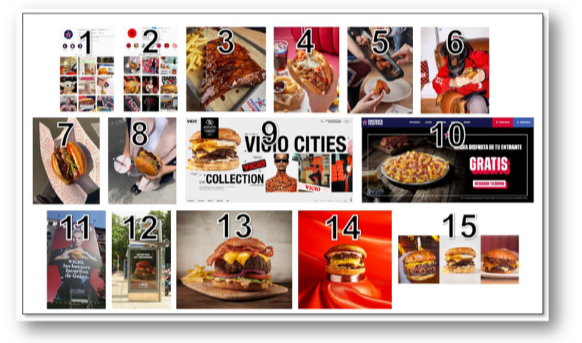
Source: Foster's Hollywood and VICIO digital and physical media.
3.2. Sample
The final sample consisted of 18 young people between 22 and 30 years old, 7 (38.8%) men, 11 (61.2%) women, all of them students at a CAM social sciences university.
3.3. Variables and measures analyzed
- Explicit measures: three variables were measured by means of a self-reported questionnaire:
- Prior knowledge of the brands: yes/no.
- Attitude towards the brand: scale from 1 to 5.
- Preference between Foster's Hollywood and VICIO.
b) Neurophysiological measures: two different consumer neuroscience techniques were used: skin conductance (GSR) and electroencephalogram (EEG) provided by BitBrain Technologies. This company specialized in neurotechnology has already collaborated in previous research such as Fernandez-Lores et al. (2023).
Galvanic skin response (GSR) measures the electrodermal response by assessing the increase in sweat gland activity upon exposure to a specific stimulus. Therefore, skin conductance width provides a direct measure of subject excitement (Venkatraman et al., 2015). The GSR device used in the present study to obtain arousal was the BitBrain GSR ring, a wireless device for real-time monitoring of electro-dermal and cardiac activity. This technique measures emotional impact, identified as the number and intensity of point changes in emotional state caused by a stimulation, external event, or task performance.
The electroencephalogram (EEG) is a non-invasive instrument that provides information from areas below the cortex and, combined with other instruments, can provide very accurate results about a subject's response to a marketing stimulus (Du Plessis, 2011). It helps to understand how the brain responds to various stimuli. Brain activity was recorded using the wearable and mobile BitBrain Dry-EEG with 12 channels at a sampling rate of 256Hz, while impedances >100dB @50Hz, >50GΩ. For the experiment, 12 electrodes, 12 A×EEG (Fp1, Fp2, AF7, AF8, F3, F4, P3, P4, PO7, PO8, O1, O2), REF (A1) and DRL (Fpz) were used.
The electroencephalogram allows us to determine the following measurements (values between 0 and 100):
-Engagement: degree of involvement or connection between the participant and the stimulus or task.
-Valence: degree of attraction, positive or negative, experienced by a stimulus/task.
-Cognitive load: cognitive resources used for the performance of a task or the visualization of a stimulus.
-Memorization: intensity of cognitive processes related to the generation of future memories during the presence of a stimulus.
Finally, in this study, the Tobii Pro X2 30/60 model eye tracker was used to track the participants' eye movements. This tool measures and records eye movements to identify pupil position using infrared light. Eye tracking makes it possible to identify and record gaze patterns to explain visual behavior in response to a specific stimulus and thus obtain information about visual attention. The results obtained are displayed through so-called heat maps, which represent graphs of data displays that, using a coloring system, indicate what the participant paid attention to and how long he/she looked at the relevant content. The areas shaded in red indicate the areas of greatest visual impact, the most attended, followed by those shaded in yellow and green (Daugherty and Hoffman, 2014).
4. RESULTS
To answer the research objective of identifying possible differences between the visual stimuli of the two brands, a mean difference analysis was performed using Student's t statistic with the responses recorded in the neuroscience devices. The results of this are reflected in table 1.
Table 1. Summary of results by brands and communication elements.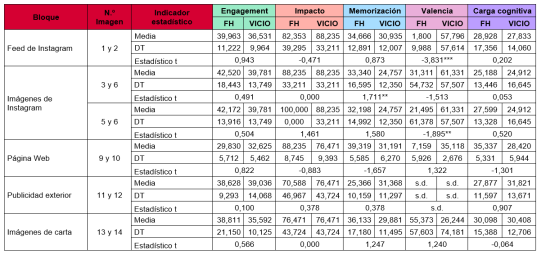
Source: Created by the authors based on metrics provided by BitBrain Technologies.
The results show that, with respect to the images analyzed in the Instagram feed, there are significant differences in the valence in favor of VICIO. This data indicates that VICIO images generate a higher degree of positive attraction compared to the images used by Foster's Hollywood in consumers. For Instagram images, the data again indicate significant differences in valence in favor of VICIO. However, the metric of memorization scores significantly higher for the Foster's Hollywood brand. As for the website, although the differences found are not significant, it is observed that VICIO's architecture generates greater engagement and liking, while Foster's Hollywood's website causes greater cognitive load, high impact and higher levels in the memorization metric.
With respect to physical communication elements, in the case of outdoor advertising, although no significant differences are found, it should be mentioned that VICIO obtains better scores in all metrics. On the other hand, the menu images present better results in Foster's Hollywood than in VICIO, according to the evaluated metrics.
The eye-tracking analysis of the images indicates through heat maps the following results:
Figure 2. Heat maps of the Instagram feeds of Foster's Hollywood and VICIO.
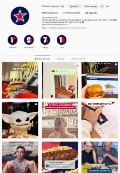
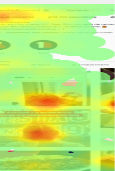
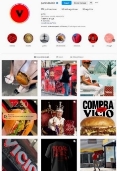
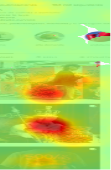
Source. BitBrain Technologies.
Analysis of the heat maps of the Instagram feed of both brands indicate, first, that eye attention is focused on the central part of the post. Specifically, in the case of Foster's Hollywood, one of its products (hamburger), located on the right, and the image of "Yoda", located in the central left part, capture the eye mostly. In the case of VICIO, the products (hamburger) also catch the eye, but the interest generated by the elements of the visual brand identity stands out.
Figure 3. Heat maps of publications on Instagram of Foster's Hollywood.






Source. BitBrain Technologies.
Figure 4. Heat maps of publications on Instagram of VICIO.






Source. BitBrain Technologies.
In the Instagram pictures of both brands, the eye is focused on the products offered by both companies; however, in the case of VICIO, image number six stands out, where the presence of the product (hamburger), despite generating high eye attention, "competes" in interest with the image of the dog's face.
Figure 5. Heat maps of publications on the WEB of Foster's Hollywood.

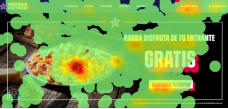
Source. BitBrain Technologies.
Figure 6. Heat maps of publications on the WEB of VICIO.
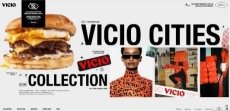
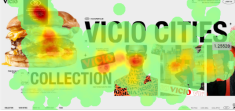
Source. BitBrain Technologies.
The heat maps of the images on the websites of both brands show aspects to be highlighted in each case. On the one hand, most of the content of Foster's Hollywood's website is subordinated to the interest generated by the potato chips product that appears in the central part of the website. In the case of VICIO, although the visual focus is also on the product, however, the point of greatest visual interest is concentrated in the cookies section. Specifically, in the following content: "if you access this website you may get what is yours".
Figure 7. Heat maps of the outdoor advertising of Foster's Hollywood and VICIO.
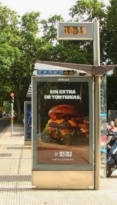
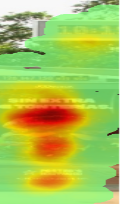
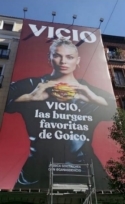
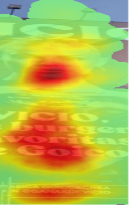
Source. BitBrain Technologies.
As for the outdoor advertising images, the heat maps indicate that the visual attention of the participants is directed, in the case of Foster's Hollywood, mainly to the product. However, in the case of VICIO, the product is subordinated to the presence of the human figure (face) of the influencer Jessica Goicoechea. Likewise, the text used in the image (VICIO, Goico's favorite burgers) captures the attention of most of the participants, along with the name of the influencer.
Figure 8. Heat maps of the menus of Foster's Hollywood and VICIO.
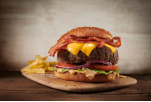


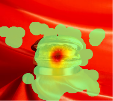
Source. BitBrain Technologies.
The analysis of the eye-tracking data from the menu images of the two brands suggests that participants primarily concentrate on the central portion of the products in both brands.
In relation to the explicit measures collected through the questionnaire, the results show (table 2) that most of the participants know the two brands analyzed, although VICIO is not known for almost 25% of the subjects. In relation to the analysis of the attitude towards the brand and the preference of the participants, VICIO obtains a higher score than Foster's Hollywood in both cases.
Table 2. Results of the explicit measures.
|
Variable |
Foster’s Hollywood |
VICIO |
|
Previous knowledge |
94.4% |
77.7% |
|
Attitude |
3.11 |
4.13 |
|
Preference |
21.42% |
78.57% |
Source. Elaborated by the authors.
5. CONCLUSIONS
The main objective of this research is to study the most effective strategy regarding the visual image in the fast-food restaurant sector, by analyzing the Foster's Hollywood and VICIO brands. Both companies develop different strategies, the former with a more traditional approach versus a more provocative strategy in the case of VICIO. For this purpose, a laboratory experiment was carried out to collect neurophysiological measurements that allow measuring the cognitive and affective processes of the subjects, objectively collected by neuroscience devices. Complementarily, participants were required to answer a self-reported questionnaire about the brands.
First, the results of the questionnaire indicate a higher degree of Foster's Hollywood brand awareness. However, with respect to brand preference, VICIO obtained clearly higher values. Likewise, in the case of the brand attitude variable, the results for VICIO are higher than those for Foster's Hollywood.
On the other hand, in the case of neurophysiological metrics, the data obtained show significant differences in the visual images used in digital media between both brands, mainly on Instagram. Specifically, the images used by VICIO generate a higher degree of positive attraction in consumers. This piece of data seems to indicate that the brand's innovative and provocative strategy achieves a high emotional connection with participants. On the other hand, the memorization metric is noteworthy, with significantly higher values in the case of Foster's Hollywood. This fact may be related to the high level of knowledge among the participants, probably originated by the long trajectory that this brand has in the market.
Furthermore, as for the website, although the differences found are not significant, it is observed that VICIO's architecture generates greater engagement and valence, while Foster's Hollywood's website generates greater cognitive load, high impact and higher levels in the memorization metric. These results suggest the need for a more in-depth study of web architecture to shed light on this issue.
With respect to physical communication elements, in the case of outdoor advertising, although no significant differences are found, it should be mentioned that VICIO obtains better scores in all metrics. These data suggest the possible effectiveness of the provocative strategy implemented by VICIO, characterized by a youthful, daring and informal tone that is very well oriented and manages to connect with the target audience.
On the other hand, the menu images present better results in Foster's Hollywood than in VICIO, according to the evaluated metrics. In this case, the selected stimuli of both brands are very similar, with traditional strategies focused on the product in both cases. This aspect could explain the results found.
In line with Stasi et al. (2018), this study uses three of the main neurophysiological tools most frequently applied by academics in neuromarketing and food studies. The combination of these tools favors the understanding of consumer decision-making in an increasingly complex environment. In addition, this study shows that visual brand images using an attractive and innovative strategy generate better positive values in affective valence. This result is consistent with the findings found by Berčík et al. (2021) in the field of neurogastronomy. Similar to the results found by Moya et al., (2020), this study finds no significant differences in several of the metrics analyzed. According to the authors, they highlight the need to take into account the experimental design, the nature of the stimuli and the context of the subjects. Also, and despite the large number of scholars researching branding and packaging using neuromarketing tools (Stasi et al., 2018), it has been found to be a relatively new discipline (Rodríguez et al., 2023), where it is not so common to find studies on visual brand identity and image. Moreover, a joint effort is required in order to achieve standardization of the theoretical and methodological context to advance the discipline.
This work paves the way for new research possibilities relevant to our discipline. The effectiveness of visual identity strategies, and therefore of communication, is not unrelated to the culture in which the brand is developed. In fact, different researchers in the field of communication have argued that the effectiveness of persuasive styles and strategies may vary from one culture to another (Woo-Jun and Lee, 2007). This suggests that, in order to achieve communication objectives, a culture-congruent style should be considered. Furthermore, previous literature highlights the importance of visual identity for corporate branding strategy, specifically for multinational companies faced with the choice between a standardized visual brand identity, as might be the case for Foster's Hollywood, versus a localized one in the case of VICIO (Henderson et al., 2003). In this regard, it would be interesting to refer to previous studies using the cultural model of Trompenaars and Hampden-Turner, (1998) and its seven dimensions to analyze the impact of communication; specifically the dimensions of neutral versus emotional and specific versus diffuse culture would shed new light on this object of study.
In today's changing market environments, it is necessary for marketers and advertisers to understand individual local cultural values and deliberately reflect on them in the execution of marketing communication messages to develop more effective and persuasive communication tools (Aaker, 2000).
In conclusion, this study makes a contribution to improving the understanding of the communication and brand identity strategies that organizations implement. Furthermore, there is a transition from the basic principles of the discipline, i.e. to conveniently connect with consumers and identify their preferences, to the essential principles of today's communication: fostering an emotional connection with the target audience and leveraging the contribution of digital media to the brand experience. A successful mix for the brand.
6. REFERENCES
Aaker, D. A. (1996). Building Strong Brands. The Free Press.
Aaker, J. L. (2000). Accessibility or diagnosticity? Disentangling the influence of culture on persuasion processes and attitude. Journal of Consumer Research, 28, 340-71. https://doi.org/10.1086/209567
Aaker, J., Fournier, S. y Brasel, S. A. (2004). When good brands do bad. Journal of Consumer research, 31(1), 1-16. https://doi.org/10.1086/383419
Arbona, A. C. (2021). Marcas con valores. EME Experimental Illustration, Art & Design. http://polipapers.upv.es/index.php/eme/article/view/15124
Berčík, J., Paluchová, J. y Neomániová, K. (2021). Neurogastronomy as a tool for evaluating emotions and visual preferences of selected food served in different ways. Foods, 10(2). https://doi.org/10.3390/foods10020354
Capriotti, P. (2009). Branding corporativo. Fundamentos para la gestión estratégica de la identidad corporativa. Santiago de Chile: Colección de Libros de la Empresa.
Daugherty, T. y Hoffman, E. (2014). eWOM and the importance of capturing consumer attention within social media. Journal of Marketing Communications, 20(1-2), 82-102. https://doi.org/10.1080/13527266.2013.797764
David, I. A., Gomes, F. S., Silva, L. A., Coutinho, G. M., Pacheco, L. B., Figueira, J. S., ... Campagnoli, R. R. (2023). Use of event-related potentials to measure the impact of front-of-package labels on food-evoked emotion. Food Quality and Preference. https://doi.org/10.1016/j.foodqual.2023.104995
Du Plessis, E. (2011). The branded mind: What neuroscience really tells us about the puzzle of the brain and the brand. Kogan Page Publishers.
Ferguson, J. L. y Mohan, M. (2020). Use of celebrity and non-celebrity persons in B2B advertisements: Effects on attention, recall, and hedonic and utilitarian attitudes. Industrial Marketing Management, 89, 594-604. https://doi.org/10.1016/j.indmarman.2019.02.003
Fernandez-Lores, S., Avelló, M., Gavilán, D. y Blasco, F. (2014). 18 años de Employer Branding hacia una definición más precisa. aDResearch ESIC International Journal of Communication Research, 10, 32-51. https://doi.org/10.7263/adresic-010-02
Fernandez-Lores, S., Crespo-Tejero, N., Fernández-Hernández, R. y García-Muina, F. E. (2023). Framing, risk perception and social health campaigns: A neuroscientific analysis. Journal of Consumer Behaviour, 1-14. https://doi.org/10.1002/cb.2151
Forbes (2022). Las hamburguesas de VICIO quintuplican sus ventas en 2022, hasta alcanzar los 20 millones. https://acortar.link/dHM40m
Fournier, S. (1998). Consumers and their brands: Developing relationship theory in consumer research. Journal of consumer research, 24(4), 343-373. https://doi.org/10.1086/209515
Gensler, S., Völckner, F., Liu-Thompkins, Y. y Wiertz, C. (2013). Managing brands in the social media environment. Journal of interactive marketing, 27(4), 242-256. http://dx.doi.org/10.1016/j.intmar.2013.09.004
Gountas, J., Gountas, S., Ciorciari, J. y Sharma, P. (2019). Looking beyond traditional measures of advertising impact: Using neuroscientific methods to evaluate social marketing messages. Journal of Business Research, 105, 121-135. https://doi.org/10.1016/j.jbusres.2019.07.011
Harris, J. M., Ciorciari, J. y Gountas, J. (2018). Consumer neuroscience for marketing researchers. Journal of Consumer Behaviour, 17(3), 239-252. https://doi.org/10.1002/cb.1710
Henderson, P. W., Cote, J. A., Leong, S. M. y Schmitt, B. (2003). Building strong brands in Asia: selecting the visual components of image to maximize brand strength, International Journal of Research in Marketing, 20, 297-313. https://doi.org/10.1016/j.ijresmar.2003.03.001
Hubert, M., Hubert, M., Florack, A., Linzmajer, M. y Kenning, P. (2013). Neural correlates of impulsive buying tendencies during perception of product packaging. Psychology & Marketing, 30(10), 861-873. https:// doi.org/10.1002/mar.20651
InfoHoreca (2023). Las hamburgueserías copan el mercado de la comida rápida. INFOHORECA. https://acortar.link/751UvI
Jan-Alsem, K. y Kostelijk, E. (2008). Identity based marketing: a new balanced marketing paradigm. European Journal of Marketing, 42(9/10), 907-914. https://doi.org/10.1108/03090560810891064
Langner, T., Schmidt, J. y Fischer, A. (2015). Is it really love? A comparative investigation of the emotional nature of brand and interpersonal love. Psychology & Marketing, 32(6), 624-634. https://doi.org/10.1002/mar.20805
Lee, H. K., Yoon, S. Y., Lee, J. Y., Kim, H. B., Kwon, H. J., Kang, H. J., ... Jun, D. G. (2015). The effects of sale signs on consumer intentions to visit a store. Journal of Global Fashion Marketing, 6(1), 20-32. https://doi.org/10.1080/20932685.2014.971495
Lim, M., Park, S., Lee, Y. y Kwak, H. S. (2023). Brain responses and connectivity to visual meal compositions: An EEG investigation into food liking. Food Quality and Preference, 112. https://psycnet.apa.org/doi/10.1016/j.foodqual.2023.105029
Madden, T. J., Fehle, F. y Fournier, S. (2006). Brands Matter: An Empirical Demonstration of the Creation of Shareholder Value Through Branding. Journal of the Academy of Marketing Science, 34(2), 224-235. https://doi.org/10.1177/0092070305283356
Mañas-Viniegra, L., Santos-Silva, D. y Liberal Ormaechea, S. (2020). The Visual-Digital Identity of Corporate Brands: A Study of Neuromarketing in Young People from Spain and Portugal. Trípodos, 48, 135-151. https://doi.org/10.51698/tripodos.2020.48p135-151
Moraes-de-Figueiredo, M. G., Campos Rodríguez, V. B. y Fernandes de Barros, M. J. (2017). The power of visual identity at restaurants in malls based on a gestalt approach. Revista ciencias administrativas, 23(3), 476-490. https://acortar.link/vjI0hB
Moya, I., García-Madariaga, J. y Blasco, M. F. (2020). What can neuromarketing tell us about food packaging? Foods, 9(12), 1856. https://doi.org/10.3390/foods9121856
Osman, H., Johns, N. y Lugosi, P. (2014). Commercial hospitality in destination experiences: McDonald's and tourists' consumption of space. Tourism Management, 42, 238-247. https://doi.org/10.1016/j.tourman.2013.12.009
Phillips, B. J., McQuarrie, E. F. y Griffin, W. G. (2014). The face of the brand: How art directors understand visual brand identity. Journal of advertising, 43(4), 318-332.
Poels, K. y Dewitte, S. (2006). How to Capture the Heart? Reviewing 20 Years of Emotion Measurement in Advertising. Journal of Advertising Research, 46(1), 18-37. https://doi.org/10.2501/S0021849906060041
Pozharliev, R., Verbeke, W. J. M. I. y Bagozzi, R. P. (2017). Social Consumer Neuroscience: Neurophysiological Measures of Advertising Effectiveness in a Social Context. Journal of Advertising, 46(3), 351-362. https://doi.org/10.1080/00913367.2017.1343162
Reason Why (2022). Foster's Hollywood hace de la autenticidad la esencia de su estrategia de reposicionamiento. https://acortar.link/PoPqvE
Rodríguez, V. J. C., Antonovica, A. y Martín, D. L. S. (2023). Consumer neuroscience on branding and packaging: A review and future research agenda. International Journal of Consumer Studies. http://dx.doi.org/10.1111/ijcs.12936
Schmuck, D., Matthes, J., Naderer, B. y Beaufort, M. (2018). The effects of environmental brand attributes and nature imagery in green advertising. Environmental Communication, 12(3),414-429. https://acortar.link/WLXsZQ
Stasi, A., Songa, G., Mauri, M., Ciceri, A., Diotallevi, F., Nardone, G. y Russo, V. (2018). Neuromarketing empirical approaches and food choice: A systematic review. Food research international, 108, 650-664. https://doi.org/10.1016/j.foodres.2017.11.049
Trompenaars, F. y Hampden-Turner, C. (1998). Riding the Waves of Culture. McGraw-Hill.
Venkatraman, V., Dimoka, A., Pavlou, P. A., Vo, K., Hampton, W., Bollinger, B., Hershfield, H., Ishihara, M. y Winer, R. (2015). Predicting advertising success beyond traditional measures: new insights from neurophysiological methods and market response modeling. Journal of Marketing Research, 52(4), 436-452. https://doi.org/10.1509/jmr.13.0593
Walla, P., Brenner, G. y Koller, M. (2011). Objective measures of emotion related to brand attitude: A new way to quantify emotion-related aspects relevant to marketing. PLoS One, 6(11), e26782. https://doi.org/10.1371/journal.pone.0026782
Whan Park, C., MacInnis, D. J., Priester, J., Eisingerich, A. B., y Iacobucci, D. (2010). Brand attachment and brand attitude strength: Conceptual and empirical differentiation of two critical brand equity drivers. Journal of Marketing, 74(6), 1-17. https://doi.org/10.1509/jmkg.74.
Woo-Jun, J. y Lee, H. S. (2007). Cultural differences in brand designs and tagline appeals. International Marketing Review, 24(4), 474-491. https://doi.org/10.1108/02651330710761035
Zhou, L. y Xue, F. (2021). Show products or show people: An eye-tracking study of visual branding strategy on Instagram. Journal of Research in Interactive Marketing, 15(4), 729-749. https://doi.org/10.1108/JRIM-11-2019-0175
AUTHORS’ CONTRIBUTIONS, FUNDING AND ACKNOWLEDGEMENTS
Conceptualization: Crespo-Tejero, Natividad; Comendador Díaz-Maroto, Sara and Fernandez-Lores, Susana. Methodology: Crespo-Tejero, Natividad; Comendador Díaz-Maroto, Sara and Fernandez-Lores, Susana. Formal analysis: Crespo-Tejero, Natividad; Comendador Díaz-Maroto, Sara and Fernandez-Lores, Susana. Data curation: Crespo-Tejero, Natividad; Comendador Díaz-Maroto, Sara and Fernandez-Lores, Susana. Drafting-Preparation of the original draft: Crespo-Tejero, Natividad; Comendador Díaz-Maroto, Sara and Fernandez-Lores, Susana. Drafting-Revision and Editing: Crespo-Tejero, Natividad; Comendador Díaz-Maroto, Sara and Fernandez-Lores, Susana. Supervision: Crespo-Tejero, Natividad; Comendador Díaz-Maroto, Sara and Fernandez-Lores, Susana. Project management: Crespo-Tejero, Natividad; Comendador Díaz-Maroto, Sara and Fernandez-Lores, Susana. All authors have read and accepted the published version of the manuscript: Crespo-Tejero, Natividad; Comendador Díaz-Maroto, Sara and Fernandez-Lores, Susana.
AUTHORS:
Natividad Crespo-Tejero
ESIC University.
natividad.crespo@esic.university
Professor of the Department of Communication and Marketing at ESIC University. PhD in Psychology from the Autonomous University of Madrid (UAM) and master's degree from the Complutense University of Madrid (UCM). She is currently the director of the academic degree in marketing and the head of the neuromarketing laboratory at ESIC University. In recent years she has published several academic articles in high impact journals focused on the study of consumer behavior and neuromarketing. Her research has been presented in more than 30 national and international conferences and she is the author of several articles and book chapters focused on the study of neuroscience. Her research interests focus on consumer behavior, neuromarketing and new technologies.
H-Index: 5
https://orcid.org/0000-0003-4541-8120
https://www.researchgate.net/profile/Natividad-Crespo-Tejero
Sara Comendador Díaz-Maroto
Alsea, Foster´s Hollywood.
She holds a degree in Business Administration and Management from the UCLM. She holds a master’s degree in marketing management from ESIC University. She is currently working as a Marketing Technician in the renowned multi-brand company ALSEA, specifically for the Foster's Hollywood brand.
Susana Fernandez-Lores
ESIC University. Business & Marketing School.
susana.fernandez@esic.university
She has a PhD in Marketing (UCM), a master’s degree in Sales and Marketing Management (IE Business School) and a degree in Advertising and Public Relations. Accredited as a full professor (ANECA), she is currently professor at ESIC University teaching undergraduate and postgraduate students, a task she combines with her work as Director of the Office of Transfer of Research Results (OTRI). She is also Editor-in-Chief of the International Academic Journal of Communication Research aDResearch ESIC and associate editor of the Spanish Journal of Marketing-ESIC. She has written numerous book chapters and academic articles (h11 index) and has participated as a speaker at academic and professional conferences. She is co-author of the Experiential Engagement at Work Model. Her research focuses on branding, communication, and new technologies.
Throughout her professional career, with more than 25 years of experience in different communication and advertising agencies, she has held different senior positions and managed all kinds of campaigns - communication, advertising, promotions or events - in coordination with the marketing and commercial departments of national and international advertisers.
H-Index: 11
ORCID: http://orcid.org/0000-0002-1164-0703
Google Scholar: https://scholar.google.es/citations?user=dY9ovcwAAAAJ&hl=es
ResearchGate:https://www.researchgate.net/profile/Susana-Fernandez-Lores-2